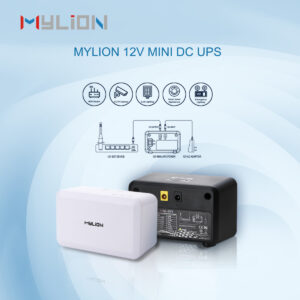When choosing a Mini UPS to protect your network gear, NAS, or home office setup, you’ll quickly encounter a fundamental choice: what type of battery is inside? The core of any UPS is its battery, and the two primary technologies are Lithium-based batteries (specifically LiFePO4) and traditional Sealed Lead-Acid (SLA) batteries.
This isn’t just a minor specification; it’s a decision that profoundly impacts the safety, lifespan, portability, and total cost of ownership of your backup power solution. This guide breaks down the key differences to help you choose the best technology for your needs.
Part 1: The Showdown: A Quick Comparison Table
| Feature | Lithium Iron Phosphate (ML1202AC Mini UPS) | Sealed Lead-Acid (SLA) | Winner |
| Energy Density | Very High (Compact & Lightweight) | Low (Bulky & Heavy) | Lithium |
| Cycle Life | Very Long (2,000 – 5,000 cycles) | Short (200 – 500 cycles) | Lithium |
| Safety | Excellent (Highly stable, less prone to thermal runaway) | Good (Sealed, but can leak or vent if abused) | Lithium |
| Upfront Cost | Higher | Very Low | SLA |
| Long-Term Value | Excellent (Rarely needs replacing) | Poor (Frequent replacements needed) | Lithium |
| Environmental Impact | Better (No heavy metals) | Worse (Contains lead and acid) | Lithium |
| Self-Discharge Rate | Very Low (~2-5% per month) | Higher (~5-10% per month) | Lithium |

Part 2: Deep Dive: Pros and Cons
1. Lithium Iron Phosphate (LiFePO4 Mini UPS- ML1202AC)
LiFePO4 is a specific type of lithium-ion chemistry renowned for its exceptional safety and long life, making it ideal for the always-on, indoor use of a Mini UPS.
Key Advantages:
Superior Safety: Its chemical structure is incredibly stable, offering high resistance to overheating, fire, and explosion—a critical advantage for a device that plugs into your wall 24/7. This is the top reason to choose it for protecting valuable electronics in your home.
Longevity: The most significant benefit. A LiFePO4 battery can last through thousands of charge-discharge cycles, often outliving the useful life of the Mini UPS itself. You will likely never need to replace the battery.
Lightweight & Compact: High energy density means manufacturers can create powerful yet incredibly sleek and portable devices that fit anywhere on a desk or in a cabinet.
Performance: Provides stable voltage output during discharge and loses its charge very slowly when not in use.
Key Disadvantages:
Higher Initial Cost: The primary barrier to entry. LiFePO4 Mini UPS units command a premium price compared to their SLA counterparts.
Low-Temperature Performance: Efficiency can drop in extreme cold environments, though this is irrelevant for typical indoor applications.
2. Sealed Lead-Acid (SLA)
This is a mature, low-cost technology commonly found in older or budget-oriented Mini UPS models.
Key Advantages:
Low Cost: The single biggest advantage. SLA batteries are cheap to manufacture, resulting in a very low entry price for the end-user.
Key Disadvantages:
Bulk and Weight: They are large and heavy for their power capacity, making the overall product cumbersome and less portable.
Short Service Life: SLA batteries have a shorter cycle life and a finite calendar life (typically 2-3 years), even if you never use them. You must be prepared to replace the battery periodically, adding to the long-term cost.
Safety and Maintenance: While “sealed,” they can still leak corrosive acid if damaged or overcharged. They also require ventilation and are susceptible to damage from deep discharges.
Environmental Impact: They contain toxic lead and sulfuric acid, posing a significant environmental hazard if not recycled properly.

Part 3: Which One Should You Buy?
Choose a LiFePO4 Mini UPS if:
You are protecting critical or expensive equipment (e.g., a NAS full of data, a high-end PC, a home server).
Safety is your utmost priority for a device that runs unattended in your home.
You want a “set it and forget it” solution that won’t need battery replacements for many years.
You value a sleek, compact design and might want to use the UPS portably outdoors.
You have the budget to invest in a higher-quality product that offers better long-term value.
Consider an SLA Mini UPS only if:
Your budget is extremely constrained.
You only need backup power for a very short duration for a single, non-critical device (e.g., a modem).
The device will be stationed in a well-ventilated area and never moved.
You understand and accept the need for future battery replacements and the associated costs and hassle.

Conclusion
For the vast majority of users in 2025, the choice is clear: Lithium Iron Phosphate (LiFePO4) is the superior technology for Mini UPS applications.
While the initial price is higher, you are investing in unparalleled safety, a dramatically longer lifespan that translates to lower cost over time, and a modern, user-friendly design. For protecting the digital assets that power your work and home life, the advanced safety and reliability of LiFePO4 make it the wisest and most future-proof choice.




